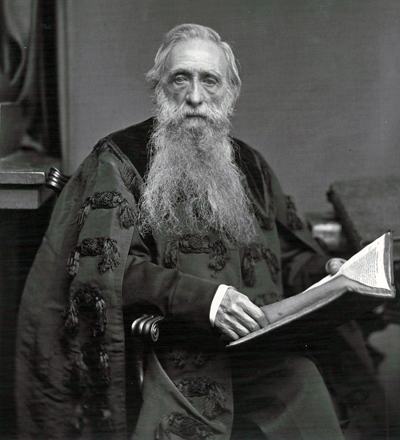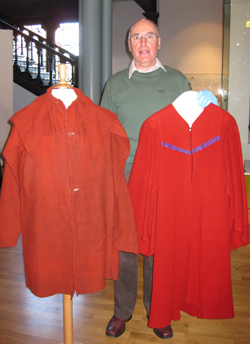Tradition and humour in academic dress
Published: 29 October 2013
Dr Neil Dickson has spent two years researching the history of academic dress at the University of Glasgow. The garments date to the 1860s and have a sometimes surprising story behind them.
By Neil Dickson
Commemoration Day and Graduation Days are splendidly colourful occasions with people wearing traditional academic dress. My research has shed new light on these traditions.
The academic dress  currently worn dates from the nineteenth century. The University did have academic dress from its foundation in 1451, but it looked very different: it was monastic in style, with cope, gown and hood. Gown designs varied greatly, but hoods generally were lined in a blue material and had fur. This type of academic dress was abandoned at the Reformation in 1560, except for gowns that continued to be worn by members of staff. Gradually a distinctive style of gown emerged that is now referred to as a professor’s gown. It had a velvet collar and long cape-like sleeves, usually with elaborate ornamentation. Figure 1 shows Principal Thomas Barclay in his professor’s gown, photographed in 1870 by Thomas Annan (courtesy of Archive Services). One such gown can still be seen in use today: it is worn by the holder of the honorary post of Dean of Faculties.
currently worn dates from the nineteenth century. The University did have academic dress from its foundation in 1451, but it looked very different: it was monastic in style, with cope, gown and hood. Gown designs varied greatly, but hoods generally were lined in a blue material and had fur. This type of academic dress was abandoned at the Reformation in 1560, except for gowns that continued to be worn by members of staff. Gradually a distinctive style of gown emerged that is now referred to as a professor’s gown. It had a velvet collar and long cape-like sleeves, usually with elaborate ornamentation. Figure 1 shows Principal Thomas Barclay in his professor’s gown, photographed in 1870 by Thomas Annan (courtesy of Archive Services). One such gown can still be seen in use today: it is worn by the holder of the honorary post of Dean of Faculties.
Academic dress, as we now know it, was created between 1868 and 1875 with black gowns for bachelors, masters and doctors, and hoods of different designs and colours for different degrees. Designs were revised in 1893 (when scarlet dress robes for doctors were introduced) and 1936, and the creation of new degrees has led to new hood colours.
Students used to wear gowns. Originally colours varied but eventually the gowns became red. Staff wore their gowns only in the University, but students were required to wear theirs throughout the town “that thereby the students may be discouraged from vaging [loitering] or vice” (a statement made in 1695). Gown wearing by students started its long slow decline in the 1860s. Figure 2 shows me with two student gowns: the one on the left is from the 1850s, the one on the right is a twentieth century gown with purple strips showing that it belonged to an Arts student.
(For a full account of this research, see Neil Dickson, Tradition and Humour: the Academic Dress of the University of Glasgow, Transactions of the Burgon Society 12 (2012), 10-35.)
First published: 29 October 2013
<< December

